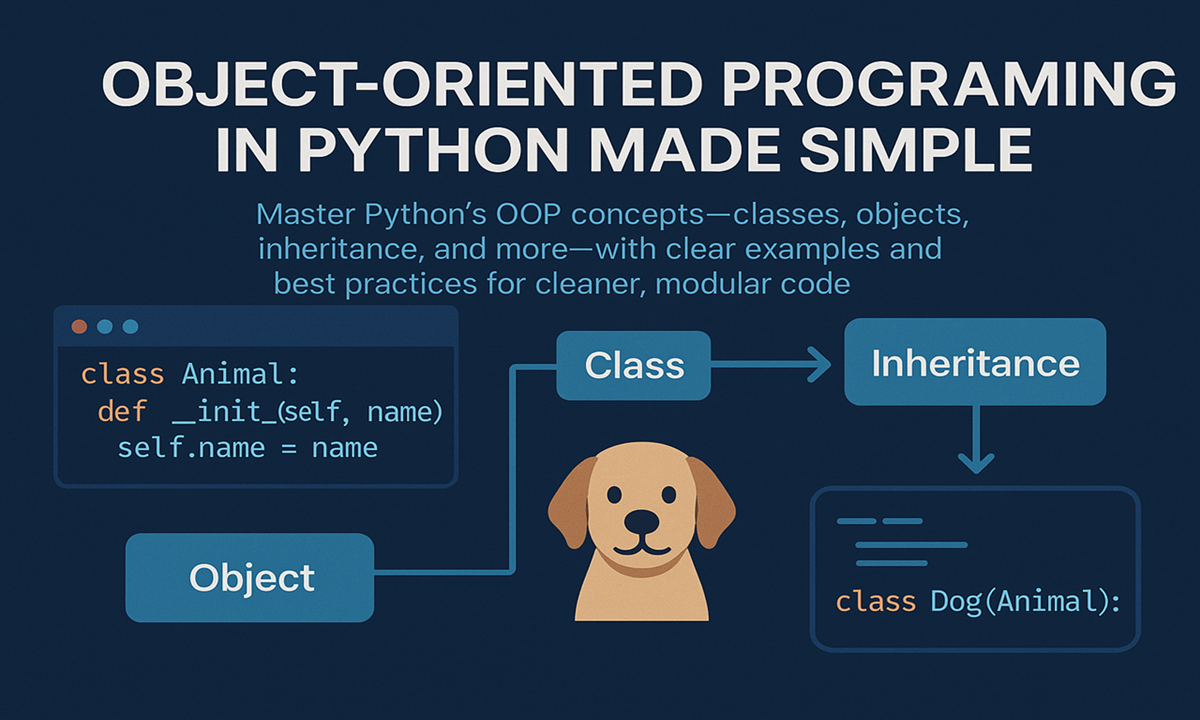Why Object-Oriented Programming (OOP) Matters in Python
Object-Oriented Programming (OOP) is a paradigm that organizes code into reusable, modular structures called classes and objects. Python’s OOP features help developers write cleaner, scalable, and maintainable code. Whether you're building a small script or a large application, understanding OOP is essential. Let’s break it down simply.
Core Concepts of OOP in Python
1. Classes and Objects
A class is a blueprint for creating objects, while an object is an instance of a class. Think of a class as a cookie cutter and objects as the cookies.
class Dog:
def __init__(self, name, breed):
self.name = name
self.breed = breed
def bark(self):
return "Woof!"
# Create objects (instances) of the Dog class
dog1 = Dog("Buddy", "Golden Retriever")
dog2 = Dog("Max", "Beagle")
print(dog1.name) # Output: Buddy
print(dog2.bark()) # Output: Woof!2. The __init__ Method (Constructor)
The __init__ method initializes object attributes when an instance is created. self refers to the instance itself.
3. Inheritance
Inheritance allows a class (child) to inherit attributes and methods from another class (parent). This promotes code reuse.
class Animal:
def __init__(self, name):
self.name = name
def speak(self):
raise NotImplementedError("Subclass must implement this method")
class Cat(Animal): # Inherits from Animal
def speak(self):
return "Meow"
cat = Cat("Whiskers")
print(cat.speak()) # Output: Meow4. Encapsulation
Encapsulation restricts direct access to an object’s data, promoting controlled modification via methods. Use private attributes (prefixed with _ or __).
class BankAccount:
def __init__(self, balance):
self.__balance = balance # Private attribute
def deposit(self, amount):
if amount > 0:
self.__balance += amount
def get_balance(self):
return self.__balance
account = BankAccount(1000)
account.deposit(500)
print(account.get_balance()) # Output: 15005. Polymorphism
Polymorphism lets methods behave differently based on the object’s class. For example, the same speak() method can produce "Meow" or "Woof" depending on the animal.
When to Use OOP in Python
- Modularity: Break down complex systems into manageable classes.
- Reusability: Inherit and extend existing classes.
- Maintainability: Isolate changes to specific classes.
Common Pitfalls to Avoid
- Overusing Inheritance: Deep inheritance hierarchies can become hard to manage. Favor composition over inheritance.
- Ignoring Encapsulation: Exposing all attributes publicly can lead to unintended side effects.
- Writing God Classes: Avoid creating classes that do too much—split responsibilities.
Real-World Example: Building a Simple Inventory System
class Product:
def __init__(self, name, price, quantity):
self.name = name
self.price = price
self.quantity = quantity
def total_value(self):
return self.price * self.quantity
class Inventory:
def __init__(self):
self.products = []
def add_product(self, product):
self.products.append(product)
def total_inventory_value(self):
return sum(product.total_value() for product in self.products)
# Usage
inventory = Inventory()
inventory.add_product(Product("Laptop", 1000, 5))
inventory.add_product(Product("Mouse", 20, 10))
print(inventory.total_inventory_value()) # Output: 5200Conclusion: OOP Makes Python Code Cleaner and Scalable
Object-Oriented Programming in Python simplifies complex problems by modeling real-world entities as objects. By mastering classes, inheritance, and encapsulation, you’ll write more organized and reusable code. Start small—refactor a script using OOP principles—and gradually apply these concepts to larger projects.
Ready to dive deeper? Experiment with polymorphism or explore Python’s @property decorator for advanced encapsulation!
